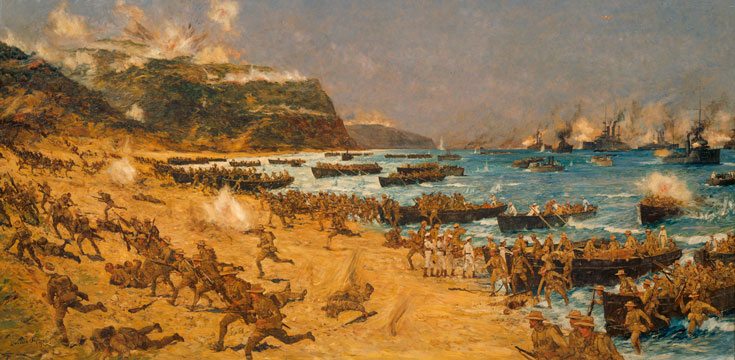14 February 2022
A different kind of Valentine
At this time of year thoughts for many turn towards a specific day in the middle of the month – Valentine’s Day. But did you know that there is a World War Two tank which carries the name Valentine? Scott Smith uncovers the story of this vehicle and some of the service personnel who served in them and are commemorated by the Commonwealth War Graves Commission.

Designed in 1938 there were more than 8,000 different variants of the Valentine Infantry Tank, which were manufactured in the United Kingdom and Canada between 1940-44. They saw action on the home front, North Africa, and the Eastern Front.
 Photo: Valentine DD tanks rigged for amphibious landing (IWM).
Photo: Valentine DD tanks rigged for amphibious landing (IWM).
Where the name of this tank comes from remains somewhat of a mystery. Some believe that it’s due to design submission being made on the 14th of February, that the designer John Carden’s middle name was used, or that it is an acronym of Vickers-Armstrong (the company which built the tanks). However, the general feeling among historians is that it’s simply a codeword used by Vickers to describe their latest design.
Today there are just over a dozen Valentine’s that survive in varying states around the world, with most residing in museums or private collections. Here in the UK we are lucky to have a running model which can be seen regularly at several military vehicle shows each year. What makes John Pearson’s 1943 Valentine MkIX tank even more special is that it is a Duplex Drive (DD) variant – in other words a swimming tank!
I’ve been fortunate enough to take a ride in John’s Valentine on more than one occasion – and I can certainly say they were built for the smaller man given the tight nature of the hull. As you ride around the peaceful English countryside though, it is hard to imagine what those on-board felt like as they slipped into the water from landing craft to start their swim to shore, thanks to the ingenious amphibious design. But John tries his best to give a flavour of this by keeping his tank running and by ensuring his vehicle honours those who died while serving in them during World War Two.
Although this Valentine didn’t see action on the battlefield, in April 1944 an incident involving Valentine DD tanks off the south coast of England would cost the lives of six British service personnel.
On 4th April 1944, six weeks before Operation Overlord, members of the 4th/7th Royal Dragoon Guards, Royal Armoured Corps were taking part in Exercise Smash 1 at Studland Bay, Dorset in preparation for D-Day. Soon after the Valentine DDs had launched into the sea the weather worsened and six of the tanks were swamped – ending up at the bottom of Studland Bay. As a result, six men lost their lives on that fateful day:
Lieutenant Charles Robert Gould - Lieutenant Charles Robert Gould | War Casualty Details | CWGC
Serjeant Victor Hartley - Serjeant Victor Hartley | War Casualty Details | CWGC
Trooper Albert Victor Kirby - Trooper Albert Victor Kirby | War Casualty Details | CWGC
Corporal Arthur Jackson Park - Corporal Arthur Jackson Park | War Casualty Details | CWGC
Trooper Ernest Granville Petty - Trooper Ernest Granville Petty | War Casualty Details | CWGC
Corporal Victor Noel Townson - Corporal Victor Noel Townson | War Casualty Details | CWGC
What perhaps makes this story even sadder is that five of the six who lost their lives have no known grave but the sea, being commemorated by name upon the Commission’s Brookwood 1939-45 Memorial in Surrey. The only man that does have a known grave is 20-year-old Lieutenant Charles Robert Gould who is buried at Highcliffe (St.Mark) Churchyard in Hampshire. His headstone bears the poignant words: ‘GREATER LOVE HATH NO MAN THAN THIS, THAT A MAN LAY DOWN HIS LIFE FOR HIS FRIENDS’.
The men are also remembered by a memorial plaque detailing the incident overlooking the shore where their tanks went down. Two of the six tanks sunk that day still lie on the seabed as a permanent reminder to the events of that April day which ultimately helped the Allies gain a foothold back in North-West Europe.
So, if you’re ever at a military vehicle show or a museum and get chance to see this unique vehicle, do take a few minutes to remember those gave their all while serving within them throughout World War Two.

Photos: left - Lieut Charles Robert Gould (unknown-1944) - Find A Grave Memorial: right - memorial plaque, Brookwood Military Cemetery





